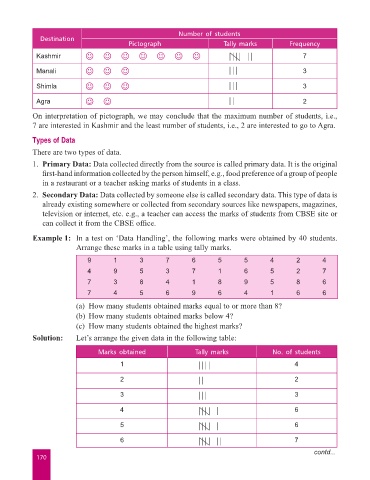Page 178 - Start Up Mathematics_6
P. 178
Number of students
Destination
Pictograph Tally marks Frequency
Kashmir 7
Manali 3
Shimla 3
Agra 2
On interpretation of pictograph, we may conclude that the maximum number of students, i.e.,
7 are interested in Kashmir and the least number of students, i.e., 2 are interested to go to Agra.
Types of Data
There are two types of data.
1. Primary Data: Data collected directly from the source is called primary data. It is the original
first-hand information collected by the person himself, e.g., food preference of a group of people
in a restaurant or a teacher asking marks of students in a class.
2. Secondary Data: Data collected by someone else is called secondary data. This type of data is
already existing somewhere or collected from secondary sources like newspapers, magazines,
television or internet, etc. e.g., a teacher can access the marks of students from CBSE site or
can collect it from the CBSE office.
Example 1: In a test on ‘Data Handling’, the following marks were obtained by 40 students.
Arrange these marks in a table using tally marks.
9 1 3 7 6 5 5 4 2 4
4 9 5 3 7 1 6 5 2 7
7 3 8 4 1 8 9 5 8 6
7 4 5 6 9 6 4 1 6 6
(a) How many students obtained marks equal to or more than 8?
(b) How many students obtained marks below 4?
(c) How many students obtained the highest marks?
Solution: Let’s arrange the given data in the following table:
Marks obtained Tally marks No. of students
1 4
2 2
3 3
4 6
5 6
6 7
contd...
170
170

